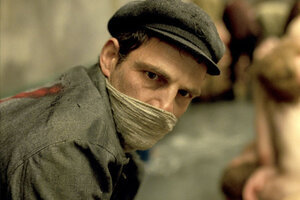'Son of Saul' has powerful sequences but is too hypercontrolled
The Holocaust drama is directed by first-time Hungarian feature film director László Nemes and stars Geza Rohrig as a Jew imprisoned in Auschwitz-Birkenau.

'Son of Saul' stars Geza Rohrig.
Sony Pictures Classics/AP
First-time Hungarian feature film director László Nemes conceived of his “Son of Saul” as a Holocaust movie like no other. Set in Auschwitz-Birkenau in 1944, it focuses on two days in the life of a Hungarian Sonderkommando, Saul Ausländer (Geza Rohrig), a Jew whose job it is to hurriedly escort newly arrived transports of Jewish prisoners to the gas chambers and then clear out the corpses. (Sonderkommandos were regularly murdered themselves by the SS, after several months.)
When, in the aftermath of a gassing, he sees the dead body of a young boy in the shower, he frantically attempts to covertly reclaim the body, track down a rabbi within the camp, and give the boy a proper Jewish burial. He says the boy is his son, but it’s not clear if this is true: It could also mean that, with this single, valiantly hopeless act, he is trying to preserve his humanity inside this inferno.
At first, with the camera almost always tightly framing Saul as he is herded and goaded by the SS on his unspeakable errands, the film has a muscular force. The headlong rush of horror is dramatized almost matter-of-factly, and Nemes does not offer up explicit images of the carnage, allowing us to fill in our own.
But Nemes’s Saul-centric stylistics grow wearisome after a while, because Saul, blank-faced throughout, never really comes to life as much more than a symbolic martyr. Co-written by Nemes and Clara Royer, the movie doesn’t really expand upon the true madness of Saul’s mission. It’s too hypercontrolled, too limited a conception, for that.
Of course, on some level, no movie about this subject can fail to move us, and “Son of Saul” has its share of powerful sequences. I wanted it to be great, though, with a largeness of vision to match the awful immensity of its subject. Grade: B (Rated R for disturbing violent content and some graphic nudity.)

